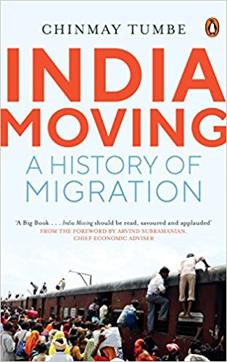Excerpt: India Moving by Chinmay Tumbe
In this excerpt from India Moving, author Chinmay Tumbe looks at the largest and longest non-coerced migration stream for work in documented history

Mere piya gaye Rangoon, kiya hai vahan se telephone,
Tumhaari yaad sataati hai, jiya mein aag lagaati hai.
— Patanga, 1949
Shamshad Begum’s famous song in a classic Hindi film about a wife bemoaning her migrant husband’s absence in the middle of the 20th century echoes the feelings of millions of women before and since… Rangoon in Burma, now Yangon in Myanmar, happened to be one of the important places in the world that saw many Indian migrants in the early 20th century, but similar voices can be unearthed across the world in songs, letters and books across eras...
What makes the Indian case unique is the sheer persistence and magnitude of this phenomenon, one that has lasted for well over a century now. It is also a phenomenon that affects regions covering at least 20 per cent of the Indian population, currently comprising over 200 million people. I call it the ‘Great Indian Migration Wave’, and it ranks among the largest and longest migration streams for work in documented history. It led to the rise of cities like Kolkata and Mumbai in India and Yangon and Dubai abroad… It played a significant role in shaping the history of modern India. Surprisingly, it is a story that has never been told.
…the Great Indian Migration Wave… is male-dominated, semi-permanent and remittance yielding. Mass migration is considered to arise from a source region where usually over 20 per cent of the households report outmigration or over 5 per cent of the population is enumerated outside. … over 70 per cent of the net outflow of migrants from a particular region comprises men. Semi-permanent durations are those where migrants spend a greater part of the year away from their homes and who do not permanently settle in their destinations. They return after working outside for a few years or even decades. Remittances are the inevitable outcome of such migrations to support families back home. Of course, some individuals and families do settle away from home, but the bulk of the migrations do not lead to permanent settlement.
…Broadly, this wave mirrors India’s engagement with the global economy, rising from the late 19th century to the 1930s and then once again since economic liberalization was introduced in 1991. These migrations have fundamentally been labour migrations towards plantations, mines and cities… Geographically, the maximum source-region impact of the wave is observed in the coastal belts, lower Indo-Gangetic plains and the northern Himalayan range. A remarkable aspect of the Great Indian Migration Wave is the near constancy of the source areas but, literally, a sea change in the destinations from the Bay of Bengal towards the Arabian Sea…
The Wave Continues
It would be difficult to write the history of Europe in the late 19th century without acknowledging the significance of the ‘Age of Mass Migration’ between Europe and the rest of the world. Similarly, it would be hard to omit the ‘Great Migration’ of African–Americans within the US in its 20th century history. And yet, the migrations that I have described in this chapter, of greater scale and enduring significance, are rarely featured in historical works on modern India...
The… Great Indian Migration Wave… stands tall among the big migration episodes of global history. The trans-Atlantic slave trade lasted for centuries but was coercive in nature. The migration of Europeans in the age of mass migration was intense, but not coerced, and lasted for less than seven decades… Compared to these episodes, the Great Indian Migration Wave is arguably the largest and longest non-coerced migration stream for work in documented history.
…What explains the tremendous persistence of the Great Indian Migration Wave even in the 21st century? To answer this question, one has to understand why most Indians chose to return home after working outside for many years, sustaining long-lasting circulatory paths. This was because of factors arising in both the source and destination regions. In some destination regions, permanent settlement was and is simply not possible due to horrendous and astronomically priced housing options… and strict legislations on citizenship, as is the case with Gulf countries. The inability to settle due to hostile conditions… automatically structured circulatory migration strategies… Departures from the general pattern of the Great Indian Migration Wave occurred precisely when women could also work in destination regions such as the tea plantations of Assam and Sri Lanka and garment knitting textile hubs across India.

The regions affected by the Great Indian Migration Wave … are also remittance economies with strong consumerist cultures, little manufacturing and a booming service economy…. The Great Indian Migration Wave… is a unique model of development where entire regions become residential sites and work is located at some distance.
The clusters and corridors of the wave shifted over time.... At times, two unrelated clusters would accidentally cross each other. For instance, Ratnagiri’s political star, Tilak, would serve out a term of imprisonment in Burma between 1908 and 1914 at the same time that the last King of Burma —Thibaw — was serving his life in exile in Ratnagiri… In other times, two corridors could unexpectedly meet through a marriage alliance. The Rai-Bachchan name signifies as much the union of two acting talents as the union of families linked with two distinct migratory corridors, one from coastal Karnataka and the other from east Uttar Pradesh, both meeting in Mumbai.
Read more: What census data on languages shows about migration in India
Such unexpected interconnections between clusters will continue in the 21st century as there is no terminal date in sight for the Great Indian Migration Wave... It is quite likely that the persistent zones, especially in the Gangetic belt, will continue to send out migrants for several more decades… If the Bihari migrant went purab in the 19th century and paschim (west) in the 20th century, dakshin (south) may be a major calling in the 21st century… The north–south corridor within India will be the latest addition to the Great Indian Migration Wave, already reflected in the fact that over 2 million north Indians work in Kerala today...
The migration songs will continue.






